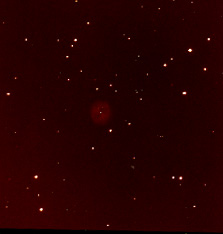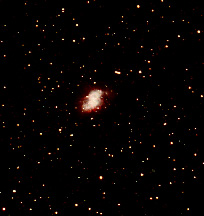Dying Stars
Now let's move our attention all the way across the sky to this area.
This is the Big Dipper or Ursa Major. Unfortunately,
at this time of the year, it is low in the northeastern sky shortly after
sunset. However, it does get higher in the sky later in the night. At
this point in the Dipper's bowl, lies another example of a planetary nebula,
M97 (NGC 3587) called the "Owl Nebula."
 Estimates of the distance to the Owl Nebula
vary greatly, but it is agreed that it is several thousand light years away.
You'll notice that right in the center of the nebulosity, there is a faint
star. This star is an example of a white dwarf star and is the key to the
nature of the planetary nebulae. In fact, the Owl Nebula has about as much
to do with owls as it does with planets! The Owl Nebula is so-called due
to its shallow resemblance to the face of an owl. The class of objects in
the sky called "planetary nebulae" are similarly named for their
resemblance to planets as viewed through a telescope. The origins of these
objects is still not understood in detail, but they are most likely the
result of a star in the red giant phase having shed its outer atmosphere
through a strong stellar wind. Contrary to popular belief, most stars do
not explode at the end of their lives (although it is true that very
massive stars do) but instead die a quiet, slow death. In fact, our own
Sun will likely form a planetary nebula in about 5 billion years. Only the
core of the Sun will then be left in the center of the nebula as a white
dwarf star.
Estimates of the distance to the Owl Nebula
vary greatly, but it is agreed that it is several thousand light years away.
You'll notice that right in the center of the nebulosity, there is a faint
star. This star is an example of a white dwarf star and is the key to the
nature of the planetary nebulae. In fact, the Owl Nebula has about as much
to do with owls as it does with planets! The Owl Nebula is so-called due
to its shallow resemblance to the face of an owl. The class of objects in
the sky called "planetary nebulae" are similarly named for their
resemblance to planets as viewed through a telescope. The origins of these
objects is still not understood in detail, but they are most likely the
result of a star in the red giant phase having shed its outer atmosphere
through a strong stellar wind. Contrary to popular belief, most stars do
not explode at the end of their lives (although it is true that very
massive stars do) but instead die a quiet, slow death. In fact, our own
Sun will likely form a planetary nebula in about 5 billion years. Only the
core of the Sun will then be left in the center of the nebula as a white
dwarf star.
Another beautiful example of a planetary nebula is the Ring Nebula (M57/ NGC
6720) in Lyra.
 It is easy to visualize how this structure could have
resulted from a star swelling up and loosing its outer atmosphere.
[Point out central star.] This
object is quite an impressive sight in a small telescope such as those at
the ETSU Observatory. Unfortunately, it is not visible this time of year,
but come to an open house at the observatory in the Summer or Fall and I
promise that you will see it!
It is easy to visualize how this structure could have
resulted from a star swelling up and loosing its outer atmosphere.
[Point out central star.] This
object is quite an impressive sight in a small telescope such as those at
the ETSU Observatory. Unfortunately, it is not visible this time of year,
but come to an open house at the observatory in the Summer or Fall and I
promise that you will see it!
As I mentioned above, very massive stars do die in violent explosions
called supernovae. After these explosions, the bulk of the star is thrown
out into space and only a small neutron star is left in the center. The
most famous example of a so-called "supernova remnant" is the Crab Nebula
(M1/NGC 1952) in Taurus. It is located near this star which is called Zeta
Tauri. It to is visible through a moderate size telescope. Here's a
photograph.
 By measuring the rate of expansion of the cloud, it is
estimated that the star exploded about 950 years ago. In fact, on the
night of July 4, 1054 it is recorded in the Chinese Annals of the Sung
Dynasty that a "guest star" appeared near the star Zeta Tauri. There
are also records of the "new star" in native American pictographs which
date from the same time. It is estimated that the Crab Nebula is about
6300 light years away. It is a source of both radio and X-ray radiation.
The remnant of the original star is now a very dense neutron star only a
few miles wide. It was discovered in 1968 that this star pulses off and on
at a rate of 30 times per second and was the first example of a "pulsar."
The star flashes this way due to the fact that it has a very strong
magnetic field which produces a beam of radiation. The star is rotating
at a rate of 30 times per second and this beam of radiation sweeps past
the Earth, similar to a lighthouse.
By measuring the rate of expansion of the cloud, it is
estimated that the star exploded about 950 years ago. In fact, on the
night of July 4, 1054 it is recorded in the Chinese Annals of the Sung
Dynasty that a "guest star" appeared near the star Zeta Tauri. There
are also records of the "new star" in native American pictographs which
date from the same time. It is estimated that the Crab Nebula is about
6300 light years away. It is a source of both radio and X-ray radiation.
The remnant of the original star is now a very dense neutron star only a
few miles wide. It was discovered in 1968 that this star pulses off and on
at a rate of 30 times per second and was the first example of a "pulsar."
The star flashes this way due to the fact that it has a very strong
magnetic field which produces a beam of radiation. The star is rotating
at a rate of 30 times per second and this beam of radiation sweeps past
the Earth, similar to a lighthouse.
[Display meteor shower!]
Go to next section.
Return to
"Planetarium Shows This Semester"



